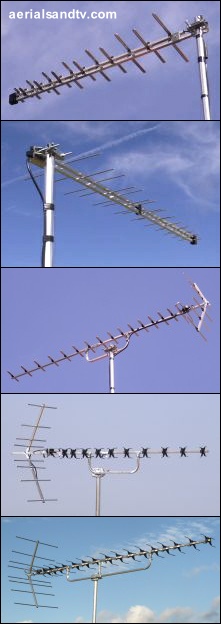FAQs : Aerials
What is a high gain aerial / what does high gain aerial mean ? : Put simply a high gain aerial will give more signal than a low gain aerial and it achieves this by having a narrower acceptance angle within which it will still work efficiently. A lower gain aerial gives less signal but has a wider acceptance angle, and, ultimately, an omni directional aerial accepts signals from all directions but at an even lower signal level. Most amplified aerials are not high gain aerials if using the correct definition of the term. More detail on high gain aerials.
Do I need a high gain aerial ? : The great majority of sites do not require a high gain aerial for domestic TV reception. High gain aerials are (by definition) larger with higher wind loading making the installations more susceptible to storm damage. In fact a significant number of sites have excessive signal levels anyway which can cause just as many problems as insufficient signal ! More detail on signal strength.
What is a digital TV aerial ? : Technically there is no such thing as a digital TV aerial. Arguably the term "digital aerial" came into use because before the digital switchover (2008 to 2012) when all transmitters were broadcasting both analogue and digital signals, but often their digital channels were in a different part of the band from their analogue output and therefore some people needed their aerials changing to receive all the digital. This, however, is no longer the case. More detail on digital aerial.

Do aerials work in the loft for digital Freeview reception ? : Whilst is is undoubtedly true that an aerial will work better outside it is also the case that, particularly since the digital switchover (2008 to 2012), there are many sites where a loft aerial will work perfectly well. However no signal will be received through any solar panels or metallic foil roof lining. More detail on loft aerials.
Can an indoor aerial work for digital Freeview reception ? / Will an indoor aerial work in my area ? : You have to live in a pretty strong signal area for an indoor "set top" aerial to give reliable reception, but despite that requirement there is still a significant minority of people for whom a set top aerial will work OK. More detail on indoor "set top" aerials.
What is a wideband aerial ? A wideband aerial is one which is designed to work across the whole of the transmitted bandwidth for TV. Their downside is they have less gain than an aerial designed to work over a smaller part of the band (i.e. a grouped aerial), although most people do not need the increased gain of the latter. More detail on wideband / grouped aerials.
Which aerial is best for Freeview digital TV ? / What is the best "digital aerial" ? Which is the best Freeview digital aerial for you actually depends on the signal strength in your particular area. However, because most people are in a reasonable signal area, the answer for most people is a relatively small good quality wideband or K group aerial, e.g. a Yagi10K or a Log36. More detail on best aerial for Freeview digital TV.
What is the difference between an aerial and an antenna ? : There is no difference in the definition of an aerial or an antenna, they're just two different words for the same thing. The word aerial tends to be used in the UK and the word antenna in the US. Personally I use the word "aerial" but I also utilise "antenna" if I have to mention aerial(s) twice in the same sentence because using the same word more than once in a sentence is poor English ! No more detail required.....


